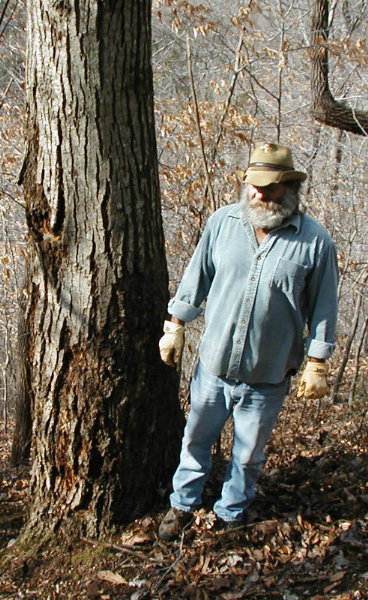![]()
The American Chestnut was often referred to as the "King of Trees" or "farmer's friend" in early tree references. Appalachian farmers used the straight-grained, rot resistant wood for split rail fences, fence posts, barns, and anything exposed to the weather. In the fall, livestock was turned into the woods to fatten up on Chestnut mast. Chestnuts were gathered and sold as supplemental income.
A favorite among loggers, the American Chestnut was a large tree comparable to the Tulip Poplar, growing to over 100 feet tall on good sites and could live several hundred years. Chestnut lumber was strong, straight grained, lightweight, and easily worked. Its uses ranged from fine furniture to utility poles.
The drought resistant, late blooming Chestnut was a dependable source of mast for wildlife. Unlike many Oaks, its nut crop was unaffected by late freezes. The Chestnut thrived on dry, well-drained slopes where many other tree species struggled.

The Largest Known Surviving American Chestnut Tree in Tennessee
The American Chestnut in its legendary tree form was reduced to scattered shrubby sprouts over most of Tennessee and the rest of its natural range by the middle 1930s. Native American Chestnuts (Castanea dentata) were and are attacked by an imported "Chestnut blight" or bark fungus disease Cryphonectria parasitica (formerly Endothia parasitica). This blight arrived in the New England area around the turn of the century and virtually wiped out all mature American Chestnuts within their natural range. The roots are not killed by the blight, only the trunk or stems. The blight also attacks native Chinquapins and to a lessor extent certain species of Oaks as alternate hosts. The original range and prevalence of the American Chestnut may have initially been reduced by "Ink Disease", Phytophthora cinnamomi, a fungus disease imported around the mid 1800's that kills the roots and root collar.

Five Year Old American Chestnut Tree in Fall Color
The American Chestnut is regarded by some to be a lost cause. After nearly 100 years of efforts to cure or restore it, the status of the Chestnut in the wild has changed very little. The tree is thought to reproduce vegetatively (by root sprouts) and exist primarily as an understory tree. These understory trees, though now rare in some areas, occur throughout the original range. My thoughts are that if man can walk on the moon, the American Chestnut can be restored.
Breeding of resistant American Chestnut large surviving trees and intercrossing their offspring that show resistance is one method of restoration (American Chestnut Cooperators' Foundation, "ACCF"). Genetic Engineering resistance genes into the American Chestnut shows promise. (Darren Corrigan and others) Using hybrids or crossing American and resistant Asian Chestnuts and backcrossing generations of resistant offspring to Americans is yet another method. (The American Chestnut Foundation, "TACF") A natural remedy called hypovirulence, a virus infection, slows the fungus and allows trees to recover. (Sandy Anagnostakis of The Connecticut Agricultural Experiment Station and ACCF) Thanks to the hard work of modern scientists, all of these methods are making headway.
Please Support American Chestnut Restoration!!
Chestnut Articles, Organizations, and Information
Although I am a member of the American Chestnut Cooperators
' Foundation (ACCF), the purpose of this page has been to stir your interest in American Chestnuts. For details about restoration efforts and organizations, please visit my links page below. Bear in mind, opinions vary about which method should be pursued. Feel free to e-mail me.Check out these ACCF Integrated Management Timber Trees!
Integrated Management for Chestnut Blight Control
Reclaiming the American Chestnut's Old Dominion
Thanks to Darren Corrigan, Lucille and Gary Griffin, Sandy Anagnostakis, Hill Craddock, Fred Hebard, Paul Sisco and Herman Forest for their patience, kindness and responses to my many questions!
Page by Ed Greenwell
Last updated 03/03/2024
![]()